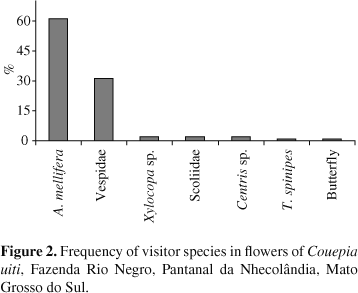The pollination biology and breeding system of Couepia uiti was studied. In this species, flowers opened at 06:00 AM anthesis, and nectar production began at around 0800 h, reached a maximum volume from 09:30 AM to 10:30 AM, and decreased thereafter. The nectar sugar concentration increased continuously, but showed an abrupt increase from 10:00 AM to 12:00 AM. Pollen release occurred at about 09:30 AM and was quickly collected. The stigmas became receptive at around 12:00 AM. The pollinators of C. uiti included the bees Apis mellifera, Xylocopa sp. and Bombus sp., and three species of wasps. This conclusion was based on the observation that these hymenopterans had C. uiti pollen on their bodies, visited the receptive flowers, and touched the anthers and stigmas, thereby promoting pollination. Of these floral visitors, A. mellifera was considered to be the most efficient pollinator. However, mixed pollination also occurred. The number of C. uiti flowers visited in the morning (n = 52) was three times smaller than in the afternoon (n = 62), and the species richness of floral visitors was also bigger in the afternoon (eight in the afternoon versus five in the morning). This finding indicated that these floral visitors preferred to exploit nectar rather than pollen. Controlled pollination experiments showed that C. uiti was a self-incompatible species that produced fruits only by cross-pollination. Treatments such as agamospermy and spontaneous and self-pollinations did not produce fruits.
breeding system; chrysobalanaceae; Couepia uiti; hymenoptera; pollination biology





